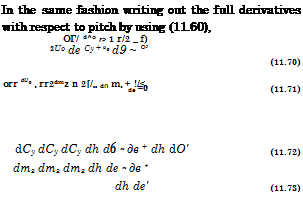The Degree of Binding of the Vehicle to the Ground
One of the parameters relevant to the design of wing-in-ground-effect vehicles is the so-called binding criterion; see Zhukov [175]. The binding criterion enables us to foresee what would be the behavior of the vehicle in height and pitch with variation in the speed of longitudinal motion. In what follows some simple quasi-static considerations will be used to relate the derivatives of the ground clearance and pitch with respect to speed to such characteristics as the static stability margin, the position of the center of mass, the magnitude of forward speed, the lift coefficient and its derivatives with respect to height and pitch; see Rozhdestvensky [182].
Suppose that the vehicle operates in a cruise mode in a state of static equilibrium with regard to vertical displacement and rotation around the lateral axis that passes through the center of mass. In this case the following equations of equilibrium hold:
Mg^Cy^-S, Mz = mz^SCo = 0. (11.60)
Z Z
|
2U0 dU0Cy + U* dCy = 0, 2U0 dU0mz + U* dmz = 0. Writing out the full derivatives with respect to height, we obtain Expressing the total derivatives by partial ones, |
|
(11.61) (11.62) (11.63) (11.64) dh ah ‘ дв dh~ dh~n ‘ de~*dh’ (1L65) Then, it follows from (11.62) and (11.63), taking into account (11.64) and (11.65), that |
|
OTT dU0 2/ auy d(Jydd Ж. ж*,с, + UQ (х, ж = 0 |
|
0TTdU° n ^TT2( 0(Jy, dUydU 2U° dh Xc*Cy + u° Xh dh +Хв дв dh)~ °- Substracting (11.67) from (11.66), we derive |
where M is the mass of the craft, g is the acceleration of gravity, Cy is the lift coefficient, U0 is the cruise speed, Mz and mz are the longitudinal moment around the center of gravity and its coefficient, respectively, p and S are the density of air and the wing reference area. Differentiating equations (11.60), we obtain
![]()
![]() 2U0^Cy(xe – xcg) + C/2(xg – *h)^ = 0,
2U0^Cy(xe – xcg) + C/2(xg – *h)^ = 0,
wherefrom follows the first binding criterion (for height)
dh 2U0Cy /xCg xq 2U^Cy /xCg ~~ xq
dU0 Cg x9-xh) Cg xh-xe)’
with

It can be easily seen that the binding criterion for pitch can be obtained from that for height by a simple substitution h -> в and в —)• h:
It follows from observation of the binding criteria (11.69) and (11.74) that for a statically stable vehicle, the location of the center of mass has a direct effect upon the response of the vehicle to an increment of speed or a horizontal gust of wind. Suppose that the vehicle is designed so that the abscissa of the center of mass coincides with the abscissa of the center of height xcg = Xh – In this case, as seen from (11.69) and (11.74), it will respond to an increment in speed by an increment in height without a change of pitch. On the other hand, if the center of mass coincides with the center of pitch xcg = x#, then the vehicle is expected to change pitch angle due to the variation in speed while flying at the same height. This consideration shows that by a thorough selection of the reciprocal locations of the three important centers (center of mass, center in pitch and center in height), one can provide static stability to the vehicle and also render its motion control system more efficient.











